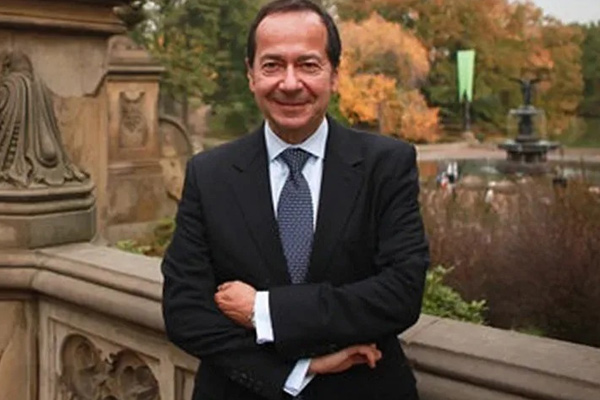Sitting Down With John Paulson of Financial Firm, Paulson & Co.: Let’s Talk Finance

Now more than ever, the financial sector is dominating headlines and a topic of major discussion by both key thought leaders and workers of all industries. After battling the “new normal” fr om the pandemic, dealing with supply chain shortages and “quiet quitting,” as well as navigating inflation and recession, the US economy has been under an eagle-eye lens for years.
And to talk about the latest key trends in finance and the US economy is none other than John A. Paulson of Paulson & Co. Paulson & Co. is a major investment management firm in New York that has been committed to capital markets, venture capital and investment for over 50 years. To this day, they have participated in more than 175 public and private offerings while raising over $1.2 billion in financings.
John Paulson himself has led quite a legacy, best known for his philanthropy and his multi-billion dollar payoff in 2007, wh ere he shorted the US housing market when he predicted the subprime mortgage crisis, betting against mortgage-securities.
His eminent interviewer is the renowned author, intellectual and journalist, Alain Elkann.
And the first topic Elkann had Paulson dive into: dedollarisation.
Substituting U.S. currency as the Medium for International Trade
Also known as dedollarisation, the idea that the US currency will dominate trade is not one that will take over any time soon, according to Paulson.
“The post-World War II economy in the US is not quite the powerhouse it used to be; its share of world GDP has come down and the world GDP— the emergence of Asia, particularly China— as an alternative economic power has risen,” Paulson explained. “There is a desire in other countries to not want to rely on the dollar as much as they have in the past and just as importantly, the U.S. also has an enormous deficit with the rest of the world in trade and investment balances which once was positive but now is negative.”
The net-net? The country’s current deficits point to the intermediate and long-term depreciation of the dollar versus other currencies. And the US central bank’s large amount of money printing may have helped to stimulate the economy, but growth based on Federal Reserve financing has caused doubt in other countries’ trust in the US economy.
Inflation was a direct result of this, Paulson continued to explain, and therefore investors and banks around the world aren’t turning to dedollarization but to another avenue: gold.
“You are better off, at this point, keeping your investment reserves in gold,” Paulson shared, knowingly. “With gold, you have the potential for appreciation; this year and in three years and five years’ time, gold will appreciate instead of the dollar.”
Up in the Hot Seat: The Federal Reserve
The question Elkann posed next is one many are asking: will the Federal Reserve stop raising interest rates soon?
Paulson finds that we are indeed approaching the end, but that doesn’t mean inflation will. He predicts inflation will continue its presence in the markets more than currently perceived.
“The Fed will likely raise the inflation rate another 50 to 100 basis points over the next few meetings and then they will reach their maximum tightening and hold it there for longer than most people anticipate— until the US experiences a severe economic shock,” he summarized. “Only after that will they have to reduce rates in order to re-stimulate the economy once more.”
The next question Elkann asked… has the Fed been doing a good job overall?
Paulson doesn’t think so— not on the easing side. From his point of view, the Fed has printed way too much money and has continued to do so for longer than necessary. Post-COVID, when the economy collapsed, the Fed had used a very stimulative monetary policy in the second quarter of 2020. Paulson believes that policy should have ended in the beginning of 2021, but instead, the printing of money has continued well into April of 2022.
“They flooded the economy with money as if money does not lead to inflation— they were happily printing $120 billion a month all through 2021 stating that it doesn’t lead to inflation when in fact it did,” Paulson revealed. “Their response was to say the inflation was actually caused by supply constraints— not by their monetary policy— so they were completely delusional in ignoring the impact of money printing and continued to print.”
The reason the economy is wh ere it is today, as Paulson notes, is because by the time the Fed realized the damage of inflation, they started to tighten aggressively and raise rates even more aggressively.
And, as it is, we have not even seen the impact of higher interest rates yet— and the negative effects might start to show real soon, warns Paulson.
A Moment on Cryptocurrencies
Paulson sees that the biggest bubble the Fed has probably created with massive money printing has been in cryptocurrencies.
“There’s no intrinsic value to any cryptocurrency— the only potential value is there’s a limited supply, and with the excess liquidity, the demand for this type of currency increased, so the prices went up,” Paulson explained. “Now, as liquidity is drying up and as rates are rising, people are selling their cryptocurrencies. Probably 99% of cryptocurrencies have evaporated to zero. It’s very unfortunate that so many people have lost so much money investing in crypto.”
Diving into the US Stock Market
With all the money floating around due to the easing policy set by the Fed in recent years, Paulson is seeing that this money is still finding its way into the stock market. And while there’s still plenty of money to buy stocks and bonds, the Fed’s new aggressive tightening means the future might look like this:
Companies will default on their debt
Bond prices will go down
Bankruptcies will increase
“It’s currently very difficult to refinance maturing debt and it’s also a lot more expensive— as a result, I expect the default rate and the bankruptcy rate to go up,” the investment leader explained. “For instance, when you borrowed money at 5% and it doesn’t mature, it doesn’t matter that rates rise, but if you have a maturity and the borrowing costs are now 12% or 13% or 15%— or not available at all— then once your bonds mature, that’s when you default.”
Point blank: Paulson warns that the market will fall over the course of this year, which will ultimately lead to the fall of stock prices.
Fortunately, he has some advice:
Depending on flexibility, keep reserves in cash
Sell stocks and fixed income securities to increase cash reserves
Wait on buying bonds— as the default rate rises, there’ll soon be better opportunities to enter the bond market
If you’re a trader, create liquidity to the extent that you can
By ensuring your dollars, you ensure your purchasing power
At the end of the day, however, an investor has to do what is best for his or her portfolio, Paulson advises, given that the market is about to head into some changes.
“Regarding stocks, the market is currently overvalued because you have the economy weakening and corporate earnings declining— every day major companies are announcing layoffs, so the unemployment rate will rise and yields are going up and the default rate as well as bankruptcies will increase,” he said. “All these should be negative for stock valuations, so while the market is going up because of the liquidity, at some point, over the course of a year, fundamentals will prevail, and the stock market will be much lower than it is today.”
A Summary of the US Economy
Paulson sees the economy as one big party right now— one that is heading towards a hang-over.
“At some point, we’ll have to either repay the debt caused by the Fed’s enormous stumulus and money-printing, or inflate the economy to monetize the debt,” Paulson advised. “Prices are rising more than wages, so the real purchasing power of American consumers has gone down, so yes, we are going into a recession, but it looks to be a modest one.”
When it comes to the US in global affairs, Paulson sees that while NATO may be an expense to the US, the current political climate shows how important it is to remain a member.
Elkann couldn’t help but ask next what many also wonder about the US’s relationship with China: are the two headed for a sour relationship? Paulson actually finds that both see how important each are to their own economies and there’s “some level of rationalization.”
“There has been a cooling off in a re-evaluation of the relationship between the West and China,” he summarized. “Neither wants an escalation of military conflict.”
Some Final Thoughts
Paulson’s final thoughts on the stock market and economy today is that if you’re a trader, you want to take advantage of this rise in the market to sell stocks and increase cash.
“When the market — both the stock and bond market— corrects later on this year, you’ll want to have an opportunity to come back in the market at lower levels,” he advised, aptly. “For our portfolio, we reduced our net exposure, we raised cash, and at this point we have nothing long on fixed income. Although yields have risen, we’re not taking that bait and buying into bonds yet.”
Just as importantly, Paulson is a big promoter of philanthropy. He has recently made huge contributions to Harvard University and New York University, firmly believing education is the basis of society.
His other major contribution has been $100 million to Central Park, the largest park in New York.
“Over 44 million people visit Central Park every year, but what people don’t know is it’s 100% privately funded by the Central Park Conservancy— the New York City government gives nothing to maintain the park,” Paulson shared, passionately. “It’s really the heart and soul of New York, so that’s why I gave that gift to Central Park: it now looks better than ever and gives so much happiness to so many people.”
E-PR Online has been honored to organize the interview with Paulson and hopes his advice, analysis and summary of the US economy and its stock market can aid many in their own financial journeys.
Source: usreporter.com



